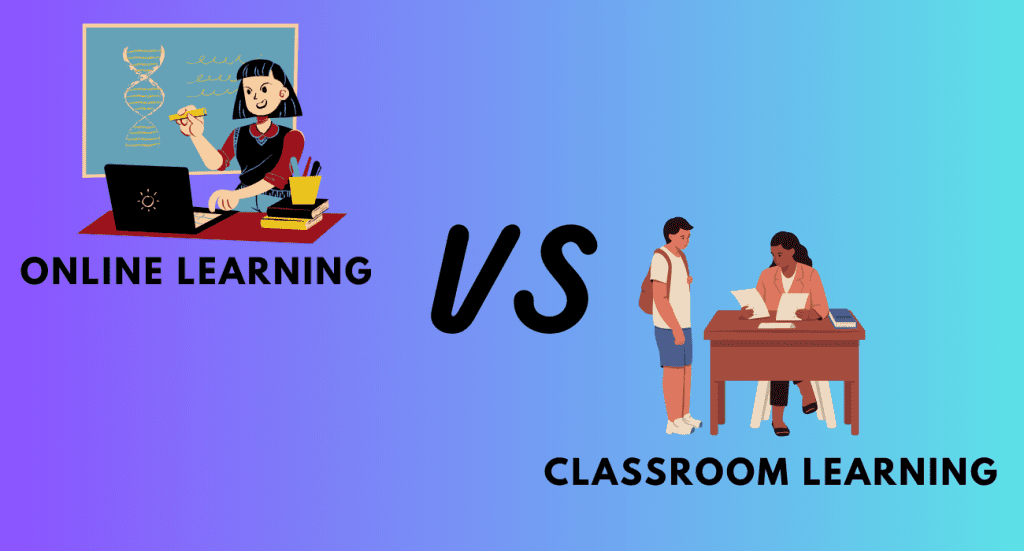The COVID pandemic resulted in empty high schools, colleges, and universities. This led the whole world to the moment when we all had to switch to a new (online) learning environment and adapt to a new teaching/learning model.
One of the things most students had to face was the necessity to take online learning classes. In other words, things like eBooks, custom writing services, homework assistance providers, web meetings, and other issues have become an integral part of the life of a typical college or university student. Below, we’ll try to get a better idea of eLearning and see who might win in the online learning vs traditional learning battle.
Online Learning Vs Traditional Learning
What Is a Cyber Class?
Remote classrooms are usually an online learning/teaching experience that lets high school, college, and university students learn, interact with peers/tutors, get together online for teamwork meetings, use the best software, and prepare for exams and tests while staying online. This kind of teaching model uses online directories, whiteboards, screen sharing, news portals, and video conferencing, all required to deliver live discussions and classes with undergrads.
What Is In-Person Classroom?
As for the lessons that you can take in a physical classroom, those are classes you take in the face-to-face learning setting where teachers and students meet at a certain time. In this model of teaching, individuals interact with each other without using any means needed to reach each other. A traditional physical classroom is usually about using class monitors, a board, projectors, and instructors.
All the ‘ingredients’ of in-person education bring positivity and focus to undergrads. In other words, students are less likely to get distracted. Why? Mainly because they are surrounded by an academic environment. Now that you know what on- and offline classes actually are about, let’s dive deeper into the differences between classroom and online learning.
Difference Between Online Learning Vs Classroom Learning: What’s the Point?
Based on various studies, online courses have increased students’ abilities to maintain info and spend less time, hinting that the changes resulting from the pandemic may stay for a longer time. Let’s take a closer look at some of the main differences between classroom and online learning environments.
When you use online learning tools for students, you have an opportunity to benefit from loads of materials at the same time – webinars, live classes, tests, web forums, articles, academic content, websites dealing with help me do my essay requests, press releases, tests, and many other cyber events.
Getting all that stuff in a printed version isn’t possible unless you have a couple of days to visit all the libraries in your city. As optimistic as it may sound, not all undergraduates have stable online connections. That is why connecting to some articles or online classes can be a problem.
Plus, since there is a space restriction in an online course, the communication session between students and instructors is comparatively less than in an in-person class. When it comes to physical courses, a tutor has an adequate area to move around and observe everyone in a room.
Read Now: How to Save Time For Study? Time Management Strategies For Students
Time Management and Flexibility In Learning
Time management plays a significant role in high school, college, or university routines, including online classes. However, cyberlearning is more flexible than its offline alternative. What is more, since you can be present at virtual classes anytime and anywhere, you do not have to travel (meaning you have more free time!). At the same time, in-person learning includes physical teaching and hands-on training from an instructor (also important in particular situations).
Cost of Online Learning and Classroom Learning
Once we take into consideration the various fees, all the study materials you are obligated to purchase, accommodation, and travel expenses, especially if your school or university is in another town, we can conclude that online learning is much more cost-effective. In fact, all you really need is a computer and internet connection.
When considering various fees, taking into account all the lists of things like accommodations, study materials that students have to buy, part-time job you would probably have to look for, travel expenses, especially if your alma mater is in another city/town, it’s no doubt that cyber courses are much more pocket-friendly. Of course, speaking of web classes, many of them aren’t free of charge.
Besides, you’ll surely have to look for ways to enhance learning at some point, which is also something you will have to pay for. However, online learning is still more affordable than courses you take in a physical classroom.
Read Now: 8 Reasons to Consider Hiring a Career Coach as a Student
Web Learning vs. Classroom: Flexibility in Learning
The other crucial difference between web and tête-à-tête learning is that cyber classes guarantee flexibility to undergrads all over the globe. What is more, e-education seems organized with small elements that are easy to grasp and manage even on the most hectic schedule.
Learners have a chance to learn fast and appear for exams/tests at a time that is more convenient for them in online learning. There’s no need to stay in a physical classroom. Besides, if there are any concepts you don’t understand in a particular lesson in a web class, you are welcome to find the course material and re-watch it as many times as you need. Whereas a conventional course has fixed timings, instructors have to manage a lot of undergrads at the same time.
How About the Teaching Tools?
Classroom and online learning use different kinds of instructional tools in order to make both the content delivery and teaching process easier.
Distance learning work for your students integrates tons of techs like online polling, educational apps, web forums, and interactive quizzes. These tools and methods promote collaboration and communication between all participants of the academic routine. You can also surf all existing web libraries, develop educational resources, and so on.
As for the classroom environment, instructors tend to use more traditional tools like projectors, boards, textbooks, and whiteboards. All these instruments can boost students’ understanding of course material, facilitate teamwork, and provide more opportunities for participation in class discussions. Undergrads engaged in in-person learning can also build their models and specimens or perform research and experiments to level up their hands-on skills and practical experience.
Learning Speed
In an in-person learning setting, a college tutor sets the speed for the whole process, while students tend to learn passively. In a professor-led classroom, there’s almost zero room for the learner to focus on complex topics more and re-learn them if necessary (this would slow down the learning progress of the whole group).
How About the E-learning Environment?
The learner is free to study at their own pace in a web-based classroom. You’re welcome to halt whenever you feel like it and get back to complex subjects as many times as you need. Due to integration assessments and interactive tools at critical points in the learning process, you are no longer a passive participant.
Conclusion
In conclusion, both physical classroom and web classes have their unique benefits. At the same time, there is also the negative impact of online learning and in-person courses that you also have to take into account. The decision that you have to make is ultimately based on your individual needs and preferences in an academic environment. Whether you decide to pursue your college/university education on the internet or in a conventional classroom, it’s crucial to pick a learning model that works best for your lifestyle, learning preferences, and academic (or even future career) goals.
Read Now: How to Choose the Right Major: Top 5 Tips for College Students
Michael C Vang is a passionate blogger. He has been blogging since 2013 on a variety of topics. He is committed to creating informative and engaging content that helps readers learn more about everything.



